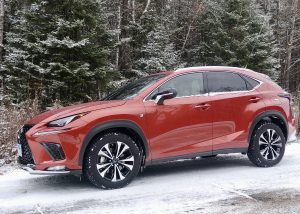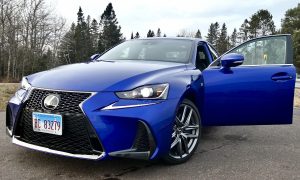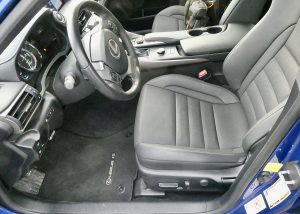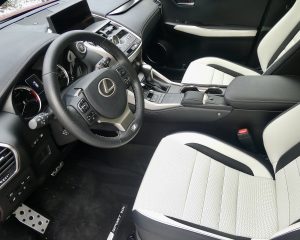Lexus crossovers cross over, add technology
By John Gilbert
As we gravitate — some would say “hurtle” — from sedans to SUVs for our vehicles of choice, we have now reached a point that obscures the very definitions of those vehicles. Take Lexus, for example, and think about whether you can identify and tell the difference among the Less RX, the Lexus UX, the Lexus GX, the Lexus NX, and the Lexus LX?
I didn’t think so.
On the off-chance you can, then let’s add in the Lexus GS, Lexus ES, Lexus IS, Lexus LS, Lexus LC, and Lexus RC. The above group are all, officially, SUVs, while the lower group is made up of cars.
We are not here to discriminate about model nomenclature, though. We’re here to describe a couple of them and how the compare, if it’s possible to differentiate. First off, Lexus is the upscale or luxury segment of Toyota, and nearly all Lexus models began life as a fancy version of a more mainstream Toyota. As years passed, Lexus got more of the upscale stuff, while Toyota absorbed the more mainstream and less expensive equipment.
I had the chance to road-test a couple of these vehicles, for a week each, and they came back to back. First came the 2020 Lexus NX 300 F Sport , a compact SUV, painted Cadmium Orange, a rich but flashy color that exacts a $595 addition to help push the base price of $40,360 to a final sticker of $51,910. Next came a 2019 Lexus IS 350 AWD sedan, painted Ultrasonic Blue Mica — also worthy of a $595 option price, helping boost the base price from $44,095 to $51,875.
Imagine that! With all the features and add-ons, these two vehicles wind up $35 different, even though they are intended for different worlds of driving. Or, are they? Both are all-wheel drive, both have different but potent engines, different transmissions, and both are F-Sport variations with firmer suspension and special features, with one being a low-slung, sporty 4-door sedan, and the other being a quite-sleek compact crossover SUV, also with four doors, and raised a bit for added room and stature.
Here’s my point: If you live in a rural area in snow country, where the county might plow your road in a day or so, you might want the slightly higher stance of the NX 300; if your driving is mostly or all on well-maintained paved roads and you favor a sporty flair to your driving, the IS 350. Both have all the anticipated contemporary safety features, with lane departure warning and assist, rear camera, blind spot monitor, etc.
An interesting evaluation would indicate the SUV handles like a sports car, and the sleek sedan has some of the capabilities of an SUV.
The IS 350 sedan surprised me a bit because it is low and quite small, and after several stops on a trip to downtown Duluth, I had to climb in and out enough that it seemed that I was more than filling that small door opening more than I hoped to. I must say that the Ultrasonic Blue Mica might be the most stunning paint job I’ve ever seen on a production car. It is not a medium bright blue, nor is it a rich, dark navy. It is a high-metallic color that stirs my soul, every time I look at it. It sis like drinking a strong cup of tea that leaves a lingering aftertaste, only this aftertaste is visual, and when the sun hits the car, you might prefer to stand outside and gaze at it, rather than climb in and drives away
Once inside the IS 350 is plenty roomy in the encapsulating front buckets. It is powered by a 3.5-liter V6, dispensing 311 horsepower and 280 foot-pounds of torque. That is a tried and true old veteran Toyota engine, durable and pretty trouble-free after living through a few hundred thousand Camrys and who knows what? Its 6-speed automatic handles the power well, and you can manually adjust the power with a console-mounted switch that takes you from normal to sport, with a special setting for snow. There also are steering wheel paddles on either side so you can upshift or downshift at the touch of your fingertips.
The exterior light-show is dazzling, with zig-zag lights up front and artistically designed taillights. Inside, special F-Sport 18-inch alloy wheels are shod with 225/40 R 18 fronts and 255/35 R 18 rears — just for those who think giving up the ability to switch wheels front to rear can be knowingly confounded by the manufacturer. The 10.3-inch navigation screen is combined with an amazing audio system, a Mark Levinson item with 835 watts piped through a 5.1-channel surround system before getting to 15 speakers. And it has a CD player!
I’m always surprised with a new car comes with all the connectivity but without a CD player. Granted, the audio world is going to MP3 players, but my guess is that everybody buying a car for the next decade has a closet-full of CDs, so even as they fade out of style, owners might find it a source of great enjoyment to be able to grab f couple old and new CDs to play on a trip.
The high-metallic orange NX 300 was, in some ways, more convenient, both for hauling stuff, and for getting in and out with greater ease. Equally as surprising as the 3.5 V6 in the sedan was that the small SUV had very good power and handling, with its F Sport upgrades, but its power was a 2.0-liter 4-cylinder engine. This engine is out of the new bin of Toyota engines, with 235 horsepower that is easily adequate in the small SUV, and gave it up to 25 miles per gallon in highway driving, and down around 20 in town, but it does need 91-octane premium fuel with its 13-1 compression ratio. Good for power, not so good for fuel economy.
The same splendid Mark Levinson audio system is included in the F Sport package, and the 835-watt sound system has 14 speakers — one less than the little sedan.
The Lexus method of designing the cons has aole is a touch pad, with a small padded thing for the palm of your hand to rest while you try to move the nav screen cursor around to adjust the audio or the climate control, with varying ease. Interestingly, the NX 300 SUV has a larger screen on the left, or driver’s side, of the console, while the IS 350 sedan has a smaller, narrower pad and a smaller touchpad. No big deal, just different.
Another difference is that the NX has the same size 18-inch wheels and all-season tires. While the sedan has the separate “snow” switch, the console switch on the NX could be turned right for sport or left for normal driving.
Those of us who have been watching Toyota closely for a few decades have heard about the new attention to less-boring, more-fun driving, and the intention to revise engines. For decades, Toyota has used a 1.8 or 2.5-liter 4 in its cars, and the new 2.0-liter 4 is from the new pallet, which means more sophisticated injection and engine-management devices,. It would not be a stretch to envision that 2.0 being refined when necessary and replace the 1.8, 2.5 and even the venerable 3.5 V6, with the turbocharger turned up as needed to provide more power or torque.
I can see that happening, but in the meantime, while we’re wondering how sedans can vanish to be replaced by small SUVs, the new Lexus models are one jump ahead, with the NX 300 handling like a sedan, and the IS 300 sedan doing what it is that makes SUVs with AWD so popular.








 John Gilbert is a lifetime Minnesotan and career journalist, specializing in cars and sports during and since spending 30 years at the Minneapolis Tribune, now the Star Tribune. More recently, he has continued translating the high-tech world of autos and sharing his passionate insights as a freelance writer/photographer/broadcaster. A member of the prestigious North American Car and Truck of the Year jury since 1993. John can be heard Monday-Friday from 9-11am on 610 KDAL(www.kdal610.com) on the "John Gilbert Show," and writes a column in the Duluth Reader.
John Gilbert is a lifetime Minnesotan and career journalist, specializing in cars and sports during and since spending 30 years at the Minneapolis Tribune, now the Star Tribune. More recently, he has continued translating the high-tech world of autos and sharing his passionate insights as a freelance writer/photographer/broadcaster. A member of the prestigious North American Car and Truck of the Year jury since 1993. John can be heard Monday-Friday from 9-11am on 610 KDAL(www.kdal610.com) on the "John Gilbert Show," and writes a column in the Duluth Reader.